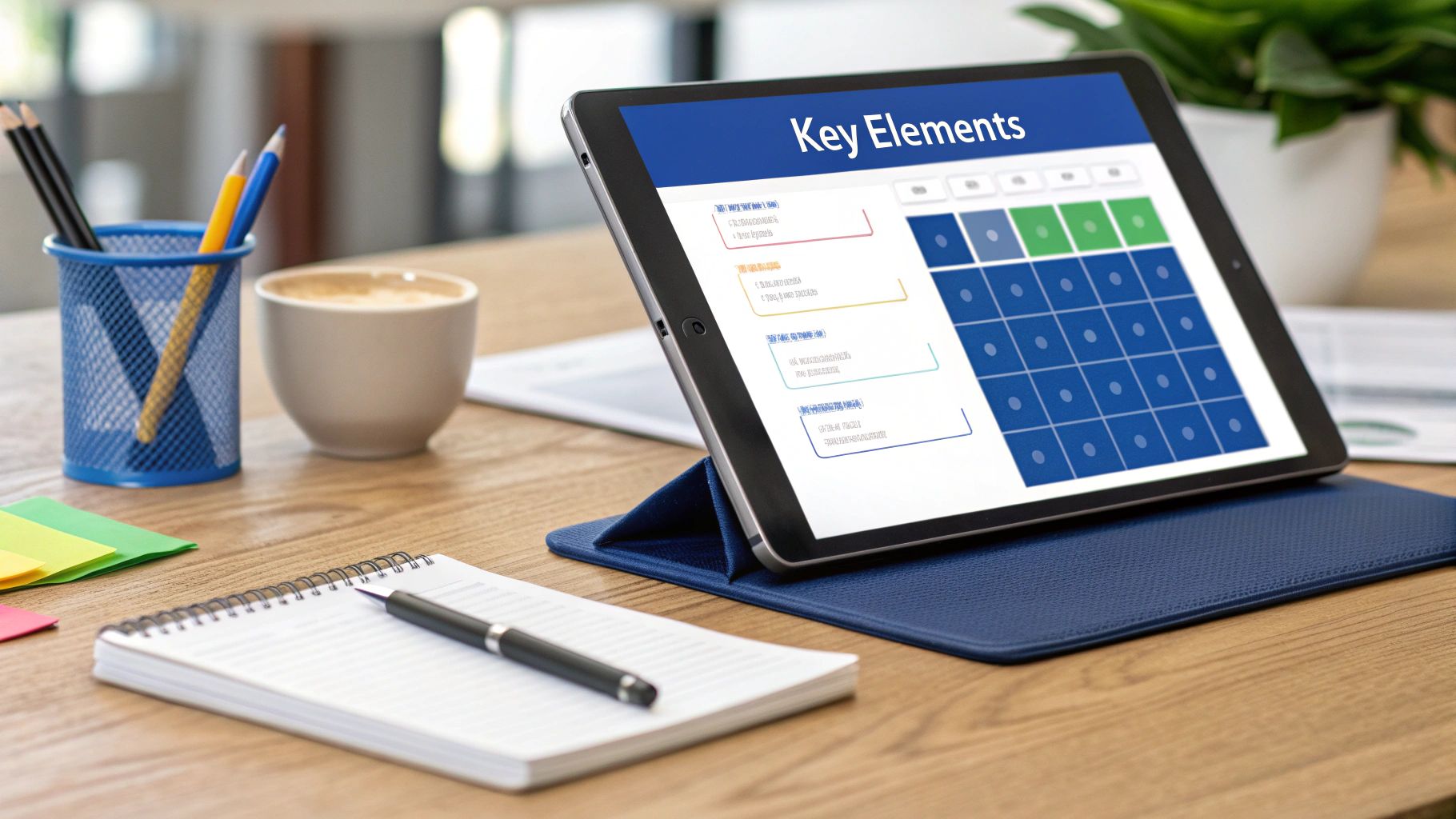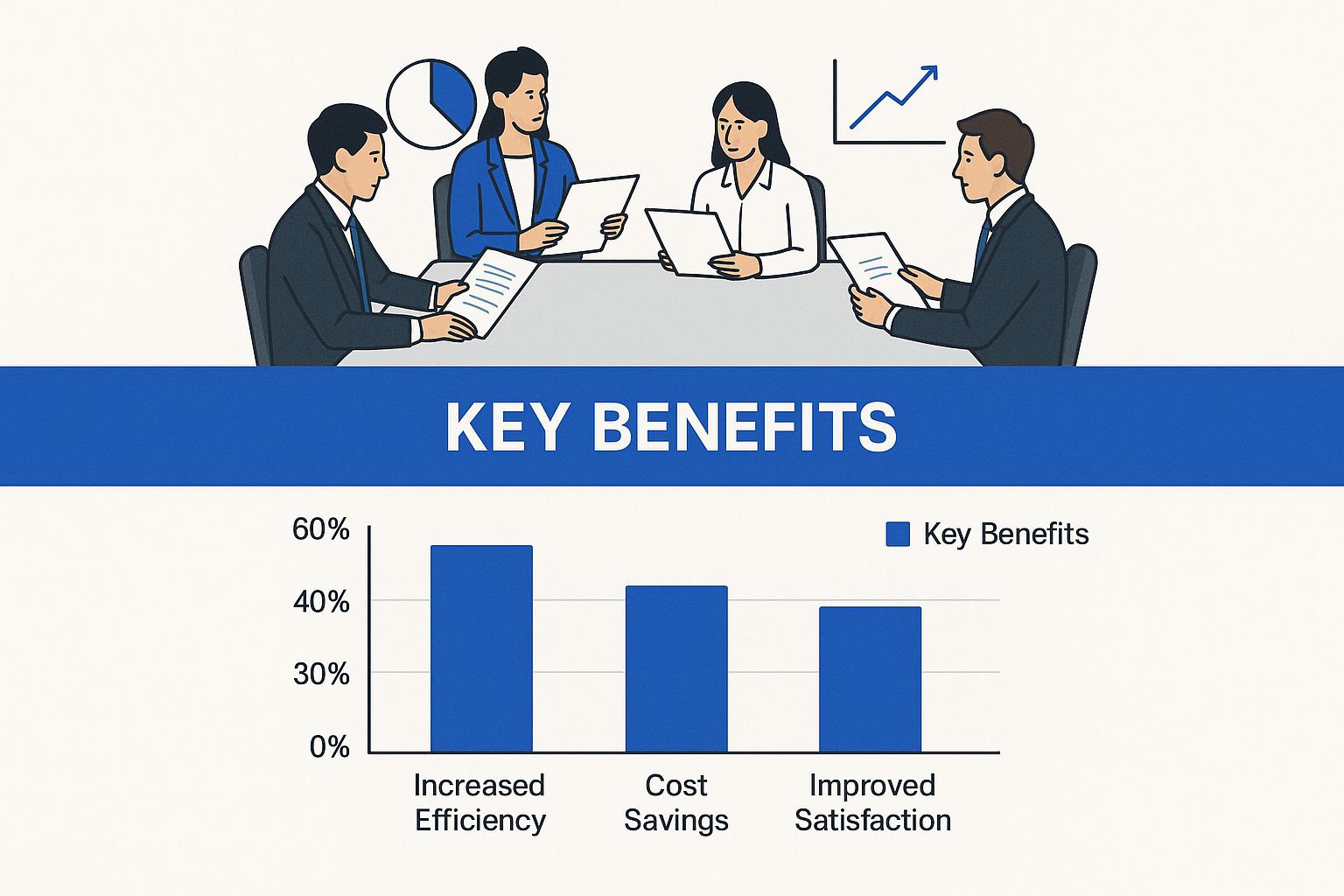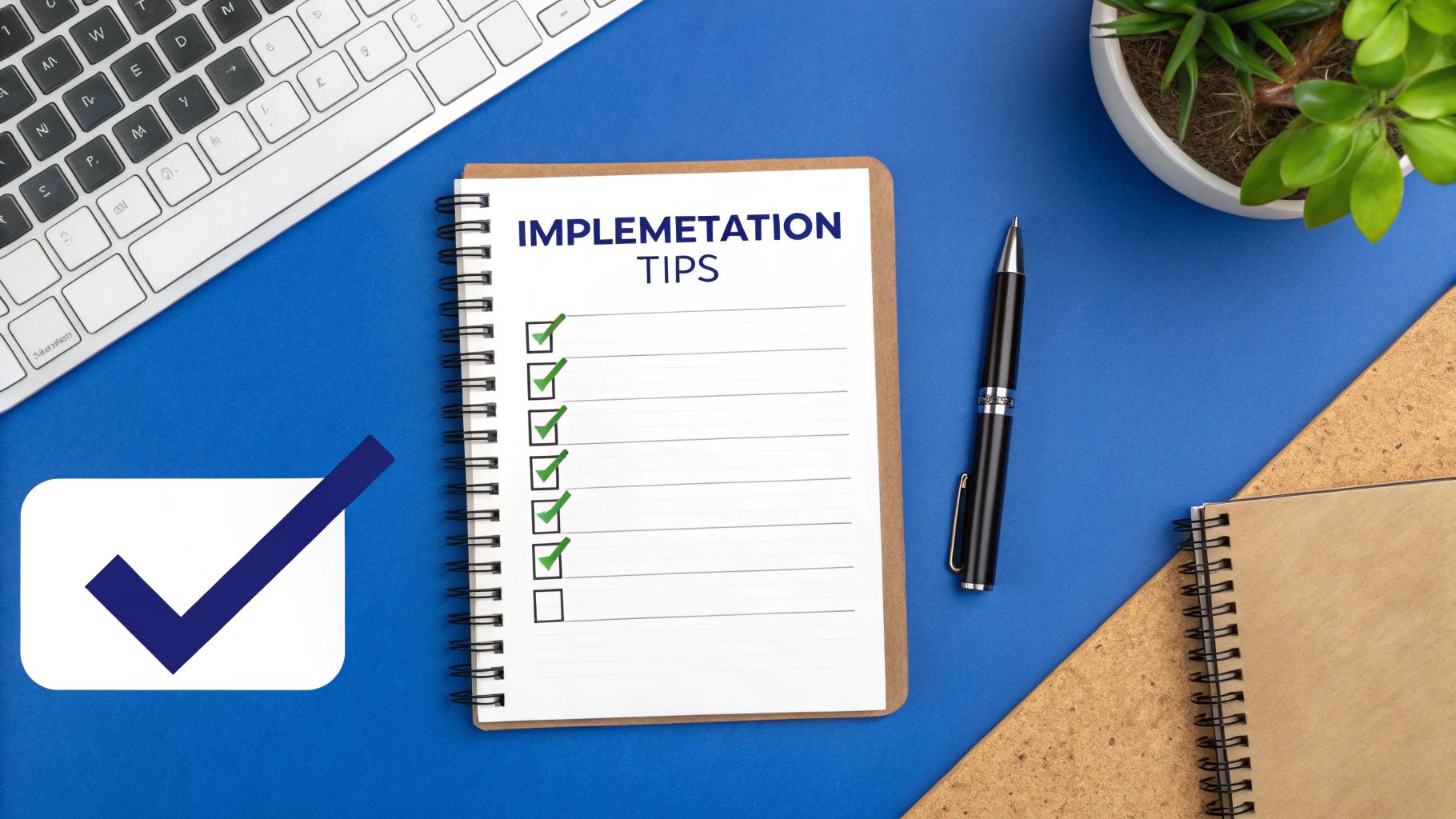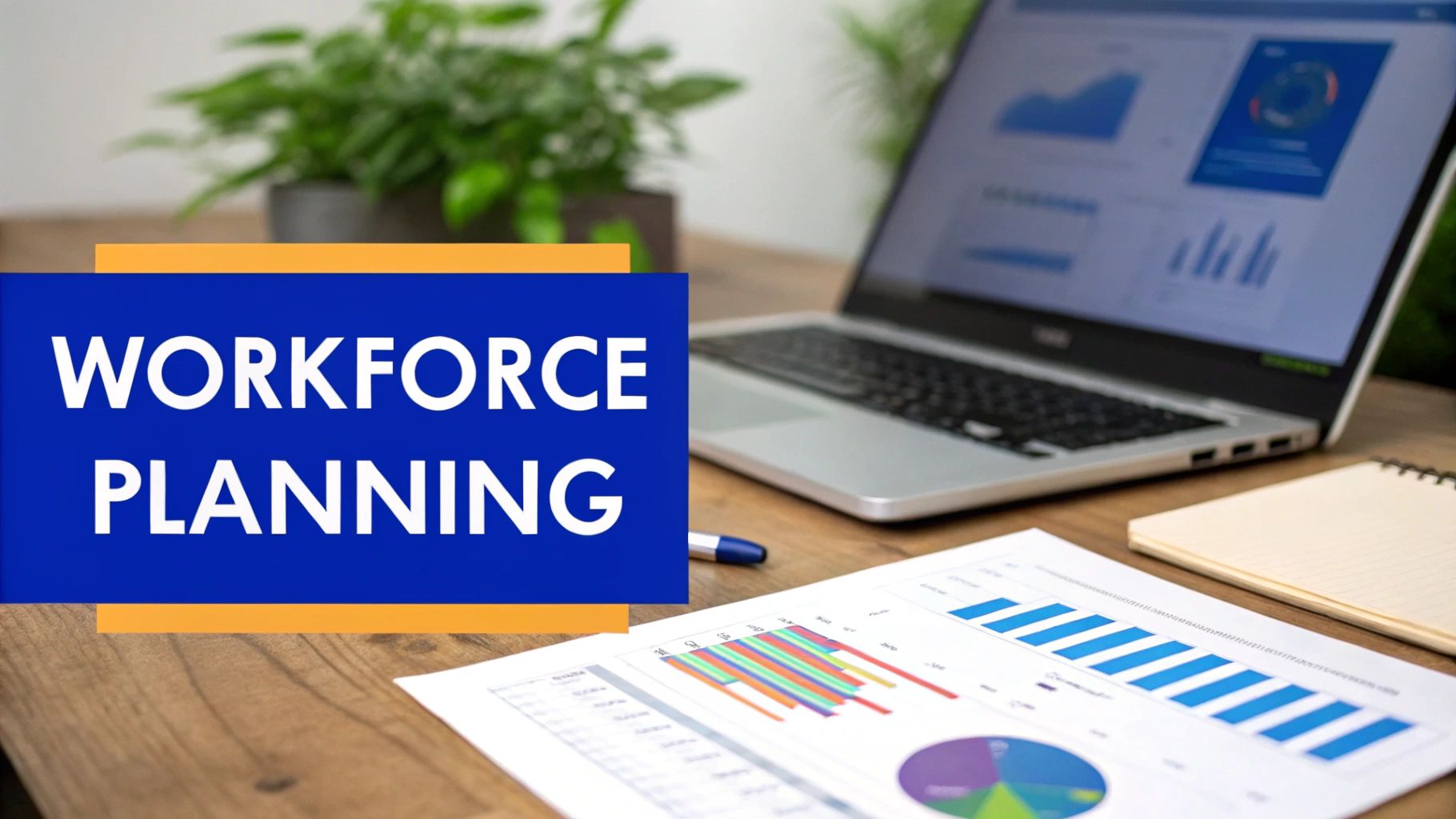A workforce planning template isn't just another spreadsheet. Think of it as a strategic roadmap that helps you get a clear picture of your current team, predict the talent you'll need down the line, and build a solid plan to bridge any gaps. It’s what shifts your hiring from a reactive scramble to a proactive strategy, making sure you have the right people with the right skills in place exactly when you need them to hit your business goals.
Why Strategic Workforce Planning Is No Longer Optional
Trying to keep up with staffing changes as they happen is a surefire way to get left behind in today's unpredictable business world. That’s why proactive workforce planning has moved out of the HR department and into the boardroom; it's a core business strategy that’s vital for stability and growth. A well-thought-out workforce planning template gives you the structure to tackle these challenges head-on.
Just look at the recent UK labour market data for a dose of reality. As of March 2025, the total number of workforce jobs was hovering around 37.1 million. Yet, between April 2024 and April 2025, the number of payrolled employees actually fell by 115,000—a drop of 0.4%. You can dig deeper into these employment trends on the ONS website. These numbers show that simply managing headcount isn't enough; you need a living, breathing plan.
From Document to Strategic Tool
A truly effective template does more than just track numbers. It prompts you to ask the tough, critical questions that directly link your people to your business objectives.
- Aligning Talent with Goals: How do our growth targets for next year actually translate into specific roles and skills we'll need to hire or develop?
- Managing Talent Risk: Where are we most vulnerable? Are critical skills concentrated in just a few people? Do we have teams with worryingly high turnover?
- Building a Future-Ready Team: What specific actions—upskilling, recruiting, or bringing in temporary expertise—do we need to take to prepare for what's next?
A great plan does more than just fill empty seats; it builds resilience right into the fabric of your organisation. When you anticipate change, you can get ahead of risks like skill shortages and make smarter, data-driven decisions about your most valuable asset—your people.
Before diving in, getting a firm grasp of the core components of the workforce planning process is the perfect starting point. Understanding this structure is key to making sure your plan is not only comprehensive and actionable but also directly tied to achieving your long-term vision.
Analyse Your Current Workforce: Building a Solid Foundation
Before you can confidently plan for the future, you need a brutally honest picture of where you stand today. A proper workforce analysis goes way beyond a simple headcount. It’s about digging into your team to map out critical skills, performance levels, and key demographics. This is how you unearth hidden risks before they become major headaches.

Think about it: what if you discovered that your most vital software development expertise is concentrated in a small group of specialists, all nearing retirement? This scenario is surprisingly common and can paralyse an organisation if it’s not spotted early. Pulling this intelligence from your HR systems is your first step towards really seeing your strengths and vulnerabilities.
Of course, to effectively analyse your current team and forecast what you'll need, your data has to be solid. This is where having a practical data strategy framework comes in, ensuring the information you’re working with is both accurate and easy to access.
Map Your Skills and Find the Gaps
Let's start by creating an inventory of the skills your business truly relies on. Your workforce planning template should have a section dedicated to precisely this. Don't get bogged down listing every single skill; instead, focus on what's absolutely mission-critical.
- Core Competencies: What skills are non-negotiable for your business to operate and thrive?
- Specialised Expertise: Are there technical or niche skills that would be incredibly difficult or expensive to replace?
- Leadership Bench: Who in your team has the potential to step into leadership roles in the next one to three years?
Going through this exercise helps you pinpoint where your talent is strong and, crucially, where you have single points of failure. If only one person holds a key certification, that’s a big red flag you need to address.
Look at Demographics and Performance
Next, it's time to layer in demographic and performance data. Start looking at metrics like age distribution, length of service, and turnover rates, especially when broken down by department. A high turnover rate in a specific team might point to a management issue, whereas an ageing workforce signals an urgent need for succession planning.
By combining skills data with demographics, you transform a flat list of employees into a three-dimensional map of your organisation’s capabilities and risks. This allows you to move from simply reacting to staffing issues to proactively shaping your team for the future.
Forecasting Your Future Talent Needs with Confidence
Guesswork simply won't cut it when it comes to strategic workforce planning. If you want to stop just reacting to staffing fires, you need to get comfortable with forecasting what talent you'll need down the road. This isn't about gazing into a crystal ball; it's about using solid data and smart analysis to predict the roles and skills your business will need to not just survive, but thrive. This is where a good workforce planning template really earns its keep.
A great place to start is with your company’s own growth plans. For instance, if you're a retail business gearing up for a major e-commerce expansion, your forecast needs to reflect that strategic shift. You’d be modelling a future with fewer in-store staff but a much greater need for digital marketing specialists, data analysts, and logistics experts. Your template is the tool that helps you translate those big-picture goals into actual headcount.
Combining Internal and External Data
The most accurate forecasts I've seen always blend internal company data with what's happening in the wider market. You have to start with what you know for sure.
- Employee Turnover Rates: Look at your historical data. If you consistently lose 10% of your tech team every year without fail, you absolutely have to factor those replacements into your plan.
- Retirement Projections: Who on your team is approaching retirement? Identifying these key people early gives you time to plan for a smooth knowledge transfer and to backfill their critical roles.
- Internal Mobility: Pay attention to how people move up and across the company. This helps you predict internal promotions and the vacancies they’ll create.
Once you have your internal picture, you need to layer on the external realities. For example, UK labour market data from early 2025 showed a monthly drop of 78,000 payrolled employees, which fed into an overall annual decline. That kind of volatility in the market shows exactly why you can't just look inward. You can explore more on these UK employment trends at the ONS.
By merging your own turnover patterns with broader market intelligence, your forecast becomes a genuinely powerful tool. It lets you see skill shortages and hiring challenges coming long before they hit your bottom line, which is a massive competitive advantage.
This kind of detailed forecasting is the essential first step before you can identify your most critical skills gaps. For a deeper look at how to pinpoint those specific shortfalls, our guide on building a skills gap analysis template is the perfect next read to complement your workforce plan.
Closing the Gap with a Practical Action Plan
You’ve done the hard work of analysing your current team and forecasting what you’ll need down the line. Now it's time to translate those insights into a concrete plan. This is where your workforce planning template really comes to life, evolving from a data repository into a genuine roadmap for your talent strategy.
The central question you need to answer is how you’ll bridge the divide between the team you have today and the team you'll need tomorrow. The most effective way to tackle this is by using the classic 'build, buy, or borrow' framework.
Your final plan will almost certainly be a blend of all three. For instance, if you see a growing need for data analysis skills across the business over the next two years, a 'build' strategy focused on training your existing people is a smart, sustainable move. But if you need a certified cybersecurity expert to start next month, 'buying' is your only realistic option.
Build, Buy, or Borrow? Choosing Your Talent Strategy
Deciding on the right mix isn't always straightforward. You have to balance how urgently you need the skills against the time and money each approach requires.
- Build (Train & Develop): This is all about upskilling and reskilling your current employees. It’s perfect for closing long-term skill gaps, nurturing loyalty, and showing your team you’re invested in their careers.
- Buy (Recruit & Hire): This means going to the external market to hire new talent. You’ll need to 'buy' when you require specialised expertise quickly or need to fill a role that’s brand new to the organisation.
- Borrow (Contract & Outsource): This strategy involves bringing in contractors, freelancers, or entire agencies for specific projects or temporary needs. It gives you incredible flexibility without the overhead of a permanent hire.
The infographic below really drives home the benefits you can unlock when you get this mix right.

As you can see, a well-thought-out plan based on these strategies is what makes a business resilient and ready for whatever comes next.
To help you weigh your options, I’ve put together a simple table that breaks down when each strategy makes the most sense. Think of it as a cheat sheet for making smarter talent decisions.
Build vs. Buy vs. Borrow Talent Strategies
Ultimately, choosing the right path depends entirely on your specific circumstances—the role, the urgency, and your budget.
A common trap I see leaders fall into is defaulting to 'buy' for every single gap. Building your internal talent pipeline through training and development is often a more sustainable and cost-effective solution in the long run. It's a powerful message to your team that you believe in their potential.
When you do decide to 'buy' and are facing a high volume of applicants, consider tools for automated candidate screening to help you efficiently find the best people.
This isn't just theory; it's a proven approach. In the UK public sector, for example, one council used a similar process to analyse its workforce. By looking at age profiles and contract types, they identified critical succession risks that could have seriously impacted public services. This kind of practical human resource planning is exactly what our template is designed for—helping you assign clear ownership, set realistic timelines, and define what success looks like for every action you take.
Making Your Workforce Plan a Living Strategy
So, you’ve filled out your workforce planning template. That’s a huge step, and you should feel proud of the work you've put in. But the real challenge starts now. The biggest mistake I see companies make is treating this plan as a one-and-done document that gets filed away in a digital folder, never to be seen again.
To get real, long-lasting value, you need to turn that plan into a living, breathing strategy that evolves right alongside your business.
First things first, you need to get everyone on board. This isn't just an "HR thing"; it's a core business tool. When you're sharing the plan with your leadership team, talk their language. Frame every talent decision in terms of business impact.
Don't just say, "We need to hire two new developers." Instead, try this: "To make sure we hit our Q4 product launch, we absolutely need two developers with Python skills in the door by the end of Q2." See the difference? That connects the dots between people and profit, making the value crystal clear to everyone.
Weaving the Plan into Your Business Rhythm
For your workforce plan to have any real teeth, it has to be part of your company's natural operating rhythm. The aim is to make thinking about people a default part of every significant decision, not a panicked afterthought.
Here’s how you can embed it:
- Budgeting Time: Your workforce plan should be a direct input for your annual budget. All those 'build, buy, or borrow' talent decisions come with a price tag that needs to be accounted for from the start.
- Strategic Planning Sessions: When the leadership team is buzzing about entering a new market or launching a new service, the immediate question should be, "Have we got the right people to make this happen?"
- Manager Conversations: Give your line managers the tools and insights from the plan so they can have meaningful career development chats with their team members. It gives those conversations real direction.
A plan that’s only dusted off once a year is already obsolete. The organisations that get this right treat their workforce plan like a dynamic dashboard, not a static report. It's there to inform today's decisions, not just summarise yesterday's actions.
You need to set up a regular review cycle. For most businesses, a quarterly check-in works perfectly. This is your dedicated time to see how you're tracking against your goals, give a shout-out for the wins, and—most crucially—tweak the plan based on what's happening in the real world.
Maybe a competitor made a move that opens up a new talent pool, or unexpected staff turnover has created a sudden gap. These reviews keep your strategy sharp, relevant, and genuinely driving your company forward.
Your Workforce Planning Questions Answered

Even with the best template in hand, putting theory into practice always brings up a few questions. From my experience, it’s these practical hurdles that often slow things down. Let’s tackle some of the most common queries I hear about using a workforce planning template so you can get started with confidence.
One of the first questions is always about frequency: “How often should we be doing this?”
A full-scale workforce plan is typically an annual exercise, usually timed to align with your main budgeting cycle. But please, don't just file it away for 12 months. Your plan needs to be a living, breathing document. I always recommend a formal review each quarter to check your progress against your goals and, more importantly, to react to changes.
Think about it – what if a key person resigns, or a sudden market shift opens up a new opportunity? If you’re in a particularly fast-moving industry, a quick monthly check-in on your core metrics is an absolute must.
Tackling Common Pitfalls And Sizing
A classic mistake I see all the time is treating workforce planning as a siloed HR task. For this to work, it has to be deeply integrated with your core business strategy. It’s a collaborative effort.
For instance, if your business strategy involves launching a new product line in nine months, your workforce plan should already be mapping out the skills and roles needed to make that happen. Without that direct connection, your plan is just an administrative exercise, not a tool that creates real business value.
The goal isn't just to fill roles, but to ensure the right talent is in the right place at the right time. Your template is the tool that helps you stay ahead, preventing you from being constantly over or understaffed.
Finally, people often ask, “Is this worth it for a small business?”
My answer is always a resounding yes. The principles are universal, regardless of your company's size. For a smaller business, the template helps you pinpoint those absolutely critical roles, prepare for what happens when a key team member leaves, and make smarter hiring decisions as you grow.
You don't need to overcomplicate it. Just focus on the essentials for your small team, like mapping your current skills and planning your next one or two hires.
For a more detailed walkthrough, Your Essential Workforce Planning Template Guide from the team at Talent People is a fantastic resource.

